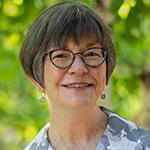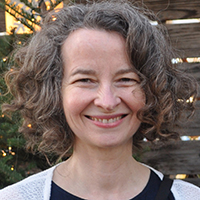Milestones & New Members
4/4/2023Leave a Comment
20YEARS+
Minnesota Chapter

Regina M. Flanagan, ASLA
Where are you from and how long have you been a landscape architect? I grew up on a dairy farm in Central Wisconsin that remains in my family today. I have two alma-maters: I graduated from the University of Wisconsin-Madison with a Masters degree in Art and returned to school to attain a graduate degree in landscape architecture at the University of Minnesota College of Design. I have training and expertise in both art and design. I received my diploma one month before the shock of September 11th, 2001, and in the unstable job market that followed, it took a while for me to land on my feet professionally as a landscape architect. Of necessity, I have carved out a unique career path for myself. For the past 12 years, I have been licensed in Minnesota. My firm, Art • Landscape • Design LLC in Saint Paul has clients including non-profit arts institutions and organizations, and state and municipal government agencies. As a solo practitioner, I am often a team member on larger projects with architecture and engineering firms. How did you begin your career journey in landscape architecture? I began my work-life journey as an arts administrator. For 17 years, I directed public art programs first for the Wisconsin Arts Board and later the Minnesota State Arts Board. I worked with artists, architects, landscape architects, engineers, bureaucrats, and local committees to integrate public art in state buildings like the Minnesota Historical Center and Minnesota Judicial Center. Did you know the term “placemaking” was first applied to public art? Creating public places through collaborations with design professionals, artists, and community members led me to landscape architecture. What do you think is the most important issue facing landscape architects today? Landscape architects need to be at the table when policy is formulated and when important land use and design decisions are made. I served on the Minnesota State Designer Selection Board that chooses teams to design major buildings around the state from museums to university buildings to armories. I was appointed by the State Arts Board. Other designated representatives came from architecture and engineering professions and the construction trades – no landscape architects. Because of my experience working within government and belief in its impact, I can see where we can be advocates and have more influence; but you have to be ready for the long game. Many young professionals are interested in policy work and that is encouraging. What have you gained by being a member of ASLA for 20 years? The ASLA Minnesota chapter’s events and annual banquet enable me to network with my peers, gain new friendships, and maintain ongoing relationships, which is critical for a solo practitioner. On the national level, Landscape Architecture magazine (LAM) and this newsletter raise up challenging work and viewpoints, and along with the conference, offer forums for discussion. What would you share with others as a reason for belonging to ASLA as a member? I believe in the influence that groups like ASLA can have on environmental legislation and policy; there’s strength in numbers and with a unified voice. LAM is a gem and a unique offering in an increasingly digitized information environment. What would you share with those new to profession of landscape architecture? The profession is becoming more diverse in all ways and that is uplifting and cause for celebration. You can find a place, even with a hybrid background and experience such as mine and maintain the energy, enthusiasm, and idealism of graduate school! What is your favorite project in your career and why? My work is multi-faceted and practice areas range from program development, master plans and policy work to community engagement and blogs. Occasionally, I produce site and planting designs and actual built work. I also write for LAM and other design periodicals and produced an essay about Millennium Park for a textbook, The Practice of Public Art, published by Routledge in 2008. I offer three examples of favorite solo projects. The first is a website I fielded for the City of Minneapolis documenting the history of public art on the Nicollet Mall downtown from the earliest examples in Lawrence Halprin’s 1968 design to the new work for the contemporary re-do by James Corner Field Operations: https://nicolletmallart.org/mall-history/mall-clock/ I also wrote the script for the Minneapolis Downtown Improvement District’s current tour of Nicollet: https://soundcloud.com/user-893458144/sets/minneapolis-art-tour The Proscenium Courtyards and Planting Plan for the Monroe (Wisconsin) Art Center, a regional treasure, was a design-build project joining the angled entrance of an historic church used for musical performances with a new gallery and offices addition. I was challenged to devise a circulation plan that dealt with some unusual site geometry and building access points, and to create places for gathering outdoors and for the display of sculpture. (“Before” and “After” photos may be seen here.) I was fortunate to work with a superb mason, Tim Haislip, who constructed the courtyard’s handsome limestone seat walls. He had produced the innovative masonry work at nearby New Glarus Brewing, home of famous Spotted Cow beer (coveted, but only available in Wisconsin). My third favorite is an ongoing series chronicling ecologically significant landscapes in transition in Minnesota and Wisconsin. Photography, analog and digital, is my primary artistic medium. www.reginaflanagan.photography I also just completed a short documentary film about the Helen Allison Savanna on the Anoka Sandplain north of the Twin Cities featuring my original photography and script, and a score/soundscape composed by Alana Horton, that is about knowing, valuing, and caring for this special place. 8. What in your view is the most important thing that landscape architects provide? The practice of landscape architecture is very broad. We touch on many aspects of our built environment, public and private lands, and increasingly, policy initiatives. We are a profession that synthesizes information, emphasizes relationships between human and non-human species, and seeks consensus in our working process – a dynamic and optimistic profession
20YEARS+
Washington Chapter

Nora Daley-Peng, ASLA
Where are you from and how long have you been a landscape architect? I grew up in the Boston area and earned my bachelors degree in landscape architecture from the University of Massachusetts at Amherst. Twenty years ago, I've became a licensed landscape architect in Washington and joined ASLA. How did you begin your career journey in Landscape architecture? Early in my career, I had the great fortune of working at a multi-disciplinary firm founded by transportation engineers. At the time, a lot of communities were reclaiming their main streets as places to be rather than simply pass through. The experience I gained from designing streets for people rather than automobiles set the trajectory of the rest of my career. What do you think is the most important issue facing landscape architects today? There are so many pressing issues in today's world, but I believe that if landscape architects help create communities where people have safe and attractive options for getting around by foot or bike, it will provide multiple benefits for human health and well being, local commerce, and the environment. What have you gained by being a member of ASLA for 20 years? Over the last 20 years, I have benefitted from my ASLA membership in many ways. The ASLA website, magazine, and social media posts have been a great source for keeping up with the latest trends in the profession as well as place to look for new employment opportunities. I have attended several ASLA annual conferences at the member-discounted rate. Through my involvement with my local ASLA chapter, I got to know fellow landscape architects in my city and made some life-long friends. What would you share with others as a reason for belonging to ASLA as a member? Becoming an ASLA member is a great way to network with local and national landscape architects. Whether it is attending a local chapter happy hour or serving on a local or national ASLA committee, the experience will enrich your professional life. What would you share with those new to the profession of landscape architecture? To those new to the profession, "Welcome! We need your fresh ideas, energy, and skills." What is your favorite project in your career and why? My favorite project was when I worked for the City of Shoreline, WA during a very transformative time when it was getting ready to open two new light rail stations. The development of light rail through the city presented a unique opportunity to design a 2.5 mile trail adjacent to the light rail alignment. The trail will provide direct pedestrian and bike access to the light rail stations, parks, schools, business districts, and connect to a growing regional trail network. That experience gave me an understanding of broad scale city planning and how linking places with movement options directly impacts a community’s quality of life. Would you like to submit/share a picture of it? See attached. Courtesy of the City of Shoreline, WA. What in your view is the most important thing that landscape architects provide? Landscape architects bring a systems thinking approach to design challenges. From considering the soil composition, to selecting plants, to anticipating how people will interact with the space and each other, landscape architects orchestrate a full spectrum of micro and macro factors that point to holistic solutions. Is there anything else you would like to share to commemorate your 20 years with ASLA? Over the past four years, I have been intently focused on how mobility innovations can support people’s daily journeys without the need of a personal vehicle. Recently, I moved to Portugal and started my consulting practice. This life change allows me to experience the rapid evolution of shared-use mobility hubs in Europe and quickly translate lessons learned to my clients in the United States.
30 YEARS
Boston Chapter
Terrence J. DeWan, FASLA
California Southern Chapter
Mia Lehrer, FASLA
Indiana Chapter
Daniel L. Ernst, ASLA
Michigan Chapter
A. John Harvey, ASLA
Woodrow S. Isaacs, III, ASLA
New York Chapter
Anthony Guccione, Jr., ASLA
Christian A. Zimmerman, FASLA
Texas Chapter
William H. Leeming, III, ASLA
David P. Thompson, FASLA
25 YEARS
Colorado Chapter
Philip E. Hendricks, Jr., ASLA
Illinois Chapter
Chris A. Durley, ASLA
Michigan Chapter
Joyce E. Weise, ASLA
Ohio Chapter
Rusty A. Wilke, ASLA
Oregon Chapter
Michael W. Zilis, ASLA
Potomac Chapter
Adele N. Ashkar, FASLA
15 YEARS
Maryland Chapter
Heather L. English, ASLA
Oklahoma Chapter
Heather Applegate, ASLA
Pennsylvania/Delaware Chapter
Larisa L. Heasley, ASLA
10 YEARS
Boston Chapter
Nathan A. Burgess, ASLA
New Hampshire Chapter
Jonathan R. Halle, ASLA
Pennsylvania/Delaware Chapter
Adam L. Byler, ASLA
Texas Chapter
Glenn Bonick, ASLA
5 YEARS
Boston Chapter
Inge Daniels, ASLA
Maryland Chapter
Michael W. Pullano, ASLA
Minnesota Chapter
Rachel M. Johnson, ASLA
Pennsylvania/Delaware Chapter
Timothy J. Hampp, ASLA
Texas Chapter
Thomas Brown, ASLA
Utah Chapter
Jeffrey Haws, ASLA
Washington Chapter
Emma Stone, ASLA
New Members
Alabama
Natali Herrmann, ASLA
Boston
Joshua D. Bourgery, ASLA
Florida
Angel Gerardo Valentin, ASLA
International Chapter
Resham Bagaria, International ASLA
Roberta Chu, International ASLA
Iowa
Laura Peters, ASLA
Mitch Walker, Affiliate ASLA
Maryland
Kathryn Benedick, Associate ASLA
Minnesota
Britta Hansen, ASLA
New Jersey
Gwen Gerhard, ASLA
Oregon
Jacob Kucharski, ASLA
South Carolina
Carissa Hood Pope, ASLA
Texas
Eliana Geoffroy, Affiliate ASLA
Washington
Holly Williams, ASLA
Martina Wirtl, ASLA
Student
Luca Antinozzi, Student ASLA
Muhammad Azher, Student ASLA
Hayden Michael Bertone, Student ASLA
Kelsey Rose Bontje, Student ASLA
Rachael K. Brown, Student ASLA
Emma Cervinka, Student ASLA
Quade Clark, Student ASLA
Tori Collicutt, Student ASLA
Georgia Elumbaring, Student ASLA
Vanessa Fajardo, Student ASLA
Drew OCanavan Farrell, Student ASLA
Demitri Costa Gadzios, Student ASLA
Jingyu Ge, Student ASLA
Andrea Padilla Guerrero, Student ASLA
Laila Hassan, Student ASLA
Jordan Horejsi, Student ASLA
Annika Jahn, Student ASLA
Cerington Jones, Student ASLA
Mustafa Kaplan, Student ASLA
Nathan Kriegermeie, Student ASLA
Tse Ting Ellie Lien, Student ASLA
Dani Lodholm, Student ASLA
Laura MacKenzie, Student ASLA
Ashley Mosel, Student ASLA
Iman Moradi Naftchali, Student ASLA
Miranda Peck, Student ASLA
Isabelle Plagge, Student ASLA
Jacob Michael Pytleski, Student ASLA
Cecelia Quay, Student ASLA
Rushell Paola Martinez Reyes, Student ASLA
Lily Saephan, Student ASLA
Jude Sander, Student ASLA
Sarah Scutti, Student ASLA
Izabella Uribe, Student ASLA
DonnoVan Vo, Student ASLA
Yuze Wang, Student ASLA
Alexander John Williams, Student ASLA
Jia Ye, Student ASLA
Student Affiliate
Bryn Carroway, Student Affiliate ASLA
Gerald Farro, Student Affiliate ASLA
Shaza Maia, Student Affiliate ASLA
Jack Mellom, Student Affiliate ASLA
Rita Musello-Kelliher, Student Affiliate ASLA
Kouassi Paul Camille Ndri, Student Affiliate ASLA
Quincy Russell, Student Affiliate ASLA
Student International
Zengrui Hua, Student International ASLA
Ming Yan, Student International ASLA
Mao Huaying, Student International ASLA
Meixi Jing, Student International ASLA
Keliang Long, Student International ASLA
Jin Ming, Student International ASLA
Yunyao Qu, Student International ASLA
Viktoriia Tupikina, Student International ASLA
Yuqing Wang, Student International ASLA
Tian Yang, Student International ASLA
Wenyan Zhang, Student International ASLA


.png)
.png)
.png)
.png)
.png)
(1).png)

